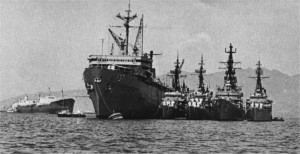 No gallant surface warrior wants to hear this, but it is high time for the US to build (or acquire) a few boring surface ship/sub tenders and fleet train support elements.
No gallant surface warrior wants to hear this, but it is high time for the US to build (or acquire) a few boring surface ship/sub tenders and fleet train support elements.
America needs these assets. Look at the aged, 37-year old USS Emory S. Land (AS 39) and USS Frank Cable (AS 40). They were both commissioned in 1979, and yet they are more relevant than ever. With both ships set to be home-ported in Guam, these elderly ships will be key (albeit unrecognized) players in the coming fight for the Pacific. Just the basic task of keeping US (and allied) boats fed and full of torpedoes (hey, wow, those old Seawolf-sized magazines might actually have made sense!), demands that tenders and fleet train elements be out there, serving the fleet.
However, tenders are perennially out of vogue. Outside of a SINKEX, our DoD accountant-warriors hate tenders and a “fleet train”–to work, tenders and other fleet train support craft need a big, pricey complement of skilled workers. It’s a big expense nobody wants to shoulder. But as ships that keep multi-billion dollar platforms working and on the front line, fleet train assets are a bargain (particularly now that the collapse of the oil patch is making a lot of interesting platforms available for low-cost charters or distressed purchases).
Today, our gallant surface warriors (still) scoff at the idea of a fleet train, but, again, look at the record–They were darn useful in the Gulf War. And they were valuable enough that in 1993 the Navy still had nine destroyer tenders, one repair ship and eleven submarine tenders on the rolls. (For comparison, in 1970 the Navy employed nine sub tenders, fifteen destroyer tenders, seventeen repair ships and 20 LST repair craft.) Today, America has two sub tenders. That’s it.
It should concern us all.
Of course, the fleet itself has changed–the logistics fleet has been civilianized, and efficiently handles peacetime demand. And with fewer small ships and a far higher standard of living for embarked crews, tenders are no longer a necessity to support normal operations. And the proliferation of basic shipyard services throughout the world has reduced the day-to-day need for a maintenance ship/tender fleet train.
But a war or threat of war (not a “beat the Iranians up again” turkey-shoot, but a real, honest-to-goodness shooting war) changes things.
War puts peacetime maintenance and supply agreements to the ultimate test. Allied facilities and services that are routinely provided in peace become anything but during a conflict.
The lack of a fleet train (of which tenders are a small part) is disconnected from current trends. Take the current excitement over survivability. It makes no sense to build ships to “be survivable” if the U.S. Navy is unable to repair the ships in the field–put bluntly, a survivable ship that can’t get home is a dead ship.
It’s great to “talk the talk” about a warfighting fleet (as so many robust Navalists often do). But they always seem to forget that a warfighting fleet is more than just those grand “ships of the line”. A warfighting fleet is made up of everything–those pesky presence ships, those lowly logistical support units and tugs and floating dry docks–one needs to project sustained maritime power. And until this country gets ALL that naval infrastructure in place to support the full span of “real shooting war combat operations” (from the pre-fight positioning to the reset), the U.S. Navy is pretty much a hollow combat force, based on the thin and unrealistic hope of winning future fights with a single salvo.
And that ain’t gonna happen. Build the darn fleet train so America can fight and win in the future.
